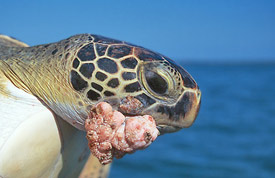
Photo: Chris Johnson,
www.turtleimages.org
www.floridaleatherbacks.com
|
“These tumored turtles are telling us that something
is happening to the oceans and we need to pay attention to
the consequences of our actions.”
Dr.
Alonso Aguirre, Vice President, Conservation Medicine at Wildlife
Trust
|
The
environment that sea turtles live in prediposes them to different
stresses that then can influence their susceptibility to health
and disease problems. The different stresses can be environmental
(salinity, pollution, temperature etc.), nutritional or physical
(trauma or injury). Both wild and captive (sea turtles held in oceanariums,
commercial farms, research instituions and head-start programmes
These
can include the following:
• Nutritional problems (malnutrition/ iron deficiency/ metabolic
bone disease)
• Bacterial
• Mycotic (Fungal infections)
• Viral
• Fibropapillomatosis (FP)
• Parasitic Conditions
• Environmental Health problems (injuries/hypothermic stunning)
• Anthropogenic Problems (entanglement/ingestion of debris/chemical
pollutants)
Nutritional
Problems
In wild sea turtles, nutritional deficiencies are usually in combination
with other chronic diseases and/or a heavy parasitic burden. Captive
sea turtles are fed a variety of diets that, if inappropriate, can
cause gastrointestinal obstructions and malnutrition and even metabolic
bone disease. Metabolic bone disease is due to improper calcium
and phosphorus levels in food given in captivity. While juvenile
captive turtles that are regularly fed diets consisting solely of
squid and fish can develop life-threatening anemias, or iron deficiencies.
Adjusting the diet and iron supplements can rehabilitate the condition.
Bacterial
Bacterial infections of the dermis (two main layers of tissue that
make up the skin) are both common and highly visible in captive
sea turtles. The symptoms on the turtle include leisons (sores),
ulceration and discolouration of the dermis. Bacterial infections
that affect sea turtles include: focal errosive dermatitis (FED);
septicemia ulcerative cutaneous disease (SCUD), papillary dermatitis
(PD); bacterial encephalitis and chylamydial infections. Treatment
includes topical (on the skin) and systemic (into the blood stream)
antibiotics, improvement in water quality, isolation of sick individuals
and frequent water changes.
Mycotic
(Fungal infections)
As sea turtles are solitary creatures, wild turtles are less vulnerable
to mycotic infections. However in captive turtles in crowded conditions
this can be a problem as fungi can spread from turtle to turtle
very quickly. The symptoms are leisons (sores) that can be located
both dermal (superficially on the skin) and systemic (infection
of internal organs). Treatment for the less serious dermal infections
includes improvement of water quality, topical iodine oitment and
free-flowing not static water input. The treatment for the systemic
infections are much more difficult and the mortality rate is very
high as it can affect vital organs such as the lungs and liver.
Viral
There are only two viral infections known to affect sea turtles,
these are herpesvirus respiratory disease and gray-patch disease
(GPD). Another disease- Fibropapillomatosis (FP) may have a viral
etiology (cause of the disease) but shall be discussed seperately
as it has such a significant impact on sea turtles. Symptoms of
herpesvirus respiratory disease include leisons in the mouth, conjunctivitis,
tracheitis (infection in the trachea leading to the lungs). This
disease can then trigger GPD especially juevinile green turtles.
High temperatures, rapid changes in temperature, overcrowding and
poor water quality are all stressors that induce this infection.
This causes death in young turtles (2-6 weeks old) but older turtles
can survive and become naturally innoculated (resistant) to the
virus.
Fibropapillomatosis
(FP)
As the incidence of sea turtles with FP have increased so rapidly
in the past few years there is a serious concern that pollution
causes vulnerability to contracting this unsightly disease.
Please see the section Fibropapillomatosis (FP) in Sea Turtles for
more information.
 Barnacle on a turtle shell
Barnacle on a turtle shell
|
Parasitic
Conditions
Sea turtles are affected by a range of parasitic conditions
both internally and externally, if there is a serious infestation
sea turtles can be severely affected. These parasites include
leeches; barnacles; endoparasites; protozoans and helminths
(parasitic worms). Leeches can occur in small or large numbers
and use oral suckers to obtain blood from their host; these
can be easily removed from captive turtles by a 90 minute
bath in fresh water. Several varieties of barnacles can be
found on sea turtles and can either do minimal stress such
as increase surface drag or more serious with damage to shell
causing bacterial or fungal infections to enter. Helminths
such as flukes can affect sea turtles causing a range of symptoms
from minor damage, irritation to leisons forming on the brain,
lungs, liver, kidney and intestines. |
 This
is a juvenile loggerhead turtle that was found as a "cold-stun"
in winter in North Carolina, and was brought into captivity
for rehabilitation before eventual release. © 2003 Matthew
Godfrey
This
is a juvenile loggerhead turtle that was found as a "cold-stun"
in winter in North Carolina, and was brought into captivity
for rehabilitation before eventual release. © 2003 Matthew
Godfrey
|
Environmental
Health problems
Environmental problems can have an impact on sea turtles with
either traumatic injuries or hypothermic stunning (or cold
stunning). Traumatic injury can occur from bite wounds from
sharks, birds, fish and during mating. Hypothermic stunning
is from long-term exposure in cold water it causes the turtle
to be lethargic and unable to function normally. They float
on the waters surface and are unable to dive and feed. In
severe cases they may die. Often they appear to be dead but
are actually stunned, when treating these cases it is the
goal to raise the body temperature slowly by immersion in
warm water. Sometimes their salt gland is affected and requires
to be maintained in fresh water until it has returned to normal. |
Anthropogenic
Problems
The impact of human pollution or ‘small garbage’ has
serious implications for the health of sea turtles and causes the
death of thousands every year. For more information about the impacts
of humans on sea turtles click here. Link to EUROTURTLE-THREATS-SMALL
GARBAGE
SOURCE:
George,
R. (1996) Health Problems and Diseases of Sea Turtles in Lutz, P.
and Musick, J. (1996) The Biology of Sea Turtles. CRC Press. USA.
|
|





